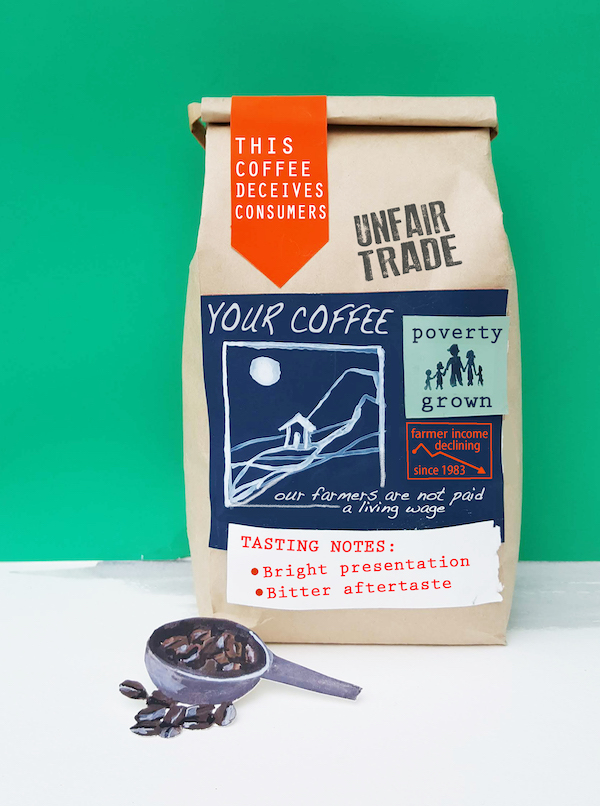
Illustration by Lauren Puchowski
This content was written by Heifer International; it was not written by and does not necessarily reflect the views of Mother Jones' editorial staff. See our advertising guidelines to learn more.
This content was created by Heifer International; it was not written by and does not necessarily reflect the views of Mother Jones’ editorial staff. See our advertising guidelines to learn more.
The scenery in Huehuetenango, Guatemala, is nothing short of spectacular. High up in the mountains, it’s lush and vibrant, awash in eye-popping shades of dense green. It’s the exact kind of image you usually see displayed on a bag of coffee or framed in a café, replete with smiling farmers proudly holding their harvest. That image may match the physical landscape, but the idyllic image promoted by scores of roasters is largely a fiction, a momentary snapshot disguising a bigger picture revealed through conversations with participants of the Heifer project I was there to visit.
As my colleagues and I chatted with one particularly memorable family, the conversation turned when we asked Osma Recinos, a coffee farmer in Villa Nueva, about her living conditions. “What we need is money,” she said, and proceeded to deftly run down the numbers. To house and feed the family, send the kids to school, and cover all basic expenses, the family needed $7,500 a year. Although they produced more high-quality coffee than anyone else nearby, they earned only $2,500 annually. “The only option is for my husband to leave,” she said, to work in another part of Guatemala or travel to Mexico or—most likely—make the dangerous journey to the United States.
Feeling stuck is common among coffee farmers. Many find their only choice is to escape certain poverty for an uncertain future across treacherous borders. For those who stay put, it means remaining tied to coffee; not only their livelihoods but their very lives depend on this bean we all take very much for granted. With market prices falling since 2016 and mostly below $1 per pound since early 2019, coffee farming families made immediate cuts on necessary household items and nutritious food. After just a few months, there was no money for medicine, transportation, or school fees. Now closing in on a year, there is barely any food or clean water, let alone money to manage any unexpected events or even basic farm investments, compounding already vicious poverty and debt.

Illustration by Lauren Puchowski
Much of the world has been buzzing about the pricing collapse. It’s often called a crisis. This implies something relatively new, a dramatic departure. “Crisis” is misleading; while the market price has indeed fallen dangerously low, it has teetered between unprofitable levels of stagnation and decline for decades. We, as consumers, don’t see this volatility; the cost of a grande latte or bag of medium-roast beans does not often significantly change. We are not meant to see the imbalance where farmers struggle to survive while corporate executives pocket millions of dollars each year.
Breaking even on coffee farming has always been a challenge, and securing a living income from it nearly impossible. Coffee prices have fallen two-thirds since the late 1970s and, with them, the income of small-scale coffee farmers. It’s hard to imagine any profession where the median salary would be that much lower today than it was almost 40 years ago. To put this into context, that’s like the average teacher earning about $17,650 in 1977 and earning $4,950 in 2019 (in reality, the average teacher in the United States earned about $60,000 in 2018). But in the coffee industrial complex, the normal rules of inflation and basic business increasingly don’t apply to producers. Farm costs skyrocketed while compensation plummeted. Many small-scale coffee farmers are operating at a staggering loss.
With the global coffee retail industry valued at as much as $100 billion, there should be plenty of money to go around. However, only a measly 0.6 to 1 percent of these huge profits gets returned to growers. A Nicaraguan household of five is living off of a total yearly income of $1,682—which includes sales of other crops and additional off-farm employment—an almost unimaginable contrast to the $11.5 million base salary raked in by a popular coffee corporation’s CEO. This same company has pledged to return $25 billion to shareholders by 2020, which is at least 12 times more than the total coffee value that all the world’s coffee farming families collectively retain.
With coffee traded at $0.95 per pound as of early 2019, prices have gone from systemically unscrupulous to downright exploitative. For farmers and their communities, it’s catastrophic. The consequences of this downward price spiral range from starving families to migrant caravans to loss of access to education and medical services.
Simply put, prices for coffee are inhumane. The system has failed these farmers; by continuing to operate within the confines of this system, we will also fail them. There is no other option but transformational action on a transformational scale.

Illustration by Lauren Puchowski
Through the years, Heifer International moved from helping coffee farmers diversify their income to improving coffee production and combating coffee rust fungus to forming cooperatives that put more power in the hands of farmers and then connects them to more profitable markets locally and internationally. Thousands are more profitable, resilient, cooperative, business-savvy, gender-sensitive, environmentally conscious, and food secure than before. I am profoundly proud of all we have accomplished and truly believe this organization spurs fundamental improvements unlike any other. But it is not enough.
Despite the best efforts of all involved, people cannot reach their full potential if they are economically oppressed. We cannot legitimately end hunger and poverty without beginning to speak up against the multitude of forces keeping them in place.
In the long term, Heifer is outlining a pathway to change. It’s obviously a complex issue, and right now, we’re determining the right areas of action while working with farmers to understand where and how best to proceed. In the meantime, there are some things you can do to support coffee farmers, including buying your coffee from companies that share how much they pay for it. We believe an appropriate starting price is $3–$4 per pound for commodity-grade coffee, although this is unfortunately rare to find on shelves. If your preferred brand or shop isn’t paying fairly, tell them so and consider shopping elsewhere.
Intentionally or not, your daily caffeine habit supports a bigger system—one that deceives consumers while taking advantage of desperate families. The only way out is for companies to pay more for coffee, the product that so generously fills the pockets of a few while millions of coffee-producing families starve. The next time you buy a cup, question how much of that $5 Guatemalan single origin is actually going back to Osma Recinos and her family in Guatemala. Consider every sip an opportunity to take a moral stance. The time has come to forge a new path, one that unequivocally and unconditionally puts farmers first.